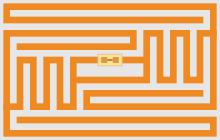Modulated backscatter
The coupling through modulated backscatter is an operation mode for the data transmission of electronic and optical signals.
The physical principle of modulated backscatter is with RFID - transponders used usually by anti-phase field weakening, with a battery-free indicator in the far field transmits a response signal.
With UHF -RFID according to ISO 18000-6, the reader sends a signal with a known frequency and coding, while the transponder in the RFID chip for the response signal changes the impedance of the antenna in rapid succession and thereby changes its reflection behavior ("switching from reflection to absorption") ). The resulting sidebands (secondary frequencies) can separate the reader from the transmitted carrier. The transponder modulates the sidebands in order to transmit information to the reader. In contrast to the inductive coupling ( load modulation ) of the HF- RFID tags (according to ISO 18000-3), greater ranges of up to 100 meters can be achieved with the permitted transmission energies.
However, interference from multipath propagation , phase rotations and superimpositions in the far field have a limiting effect on the reception possibilities.
literature
Norbert Bartneck, Volker Klaas, Holger Schönherr: Optimizing processes with RFID and Auto-ID: Basics, problem solving and application examples. John Wiley & Sons 2008, ISBN 3-8957-831-96 .
